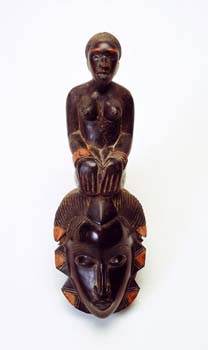Figural Mask (possibly Yaure, Guro or Baule)
- n.d.
- Artist unknown, Ivory Coast, Africa
- Carved wood
45.0 x 16.5 x 12.0 cm., 17-3/4 x 6-1/2 x 4-3/4"
- Catherine Carter Goebel, Paul A. Anderson Chair in the Arts Purchase, Paul A. Anderson Art History Collection, Augustana College 2004.22

Essay by Margaret Morse, Associate Professor of Art History
Little is known about these two masks in terms of their makers and dates of origin. The hairdresser's mask (203A) has been identified as a creation of the Yaure from central Ivory Coast, but the ethnic group that created the figural mask (203B) is uncertain. Stylistic features suggest that it too stems from the Ivory Coast; it may also be Yaure, but could derive from the Guro to the west or the Baule, the Yaure's eastern neighbors. While the three cultures possess their own languages and local traditions, they have never been isolated groups; due to their geographic proximity, over time they adapted features of each other's politics, religion, and art (Bacquart 40-41; Visona 194; Vogel 35 and 288). The two masks bear the refined formal features common to the region. While the Yaure mask is much more geometric than the figural one, both faces are pensive and idealized, with small, closed mouths and semicircular, downcast eyes to signify the importance of maintaining secrets. The oval-shaped faces each have a broad forehead, perhaps a sign of intellectual strength. The smooth and lustrous surfaces intimate clean and healthy skin. Also typical are the triangulated decoration along the cheeks and the elaborate coiffures parted on both sides, topped by some kind of ornament—on these two masks, a comb-like structure and a female figure (Bacquart 41; Visona 189; Vogel 141). Kneeling females signify fertility in many African cultures, and thus could mean something similar in this context. The Yaure mask was purportedly created for the funeral of a hairdresser, which might explain the comb-like projection at the top; however, these "horns" appear on a number of masks, and their exact significance, if any, remains unknown (Bacquart 42; Vogel 162).
For most Africans, the value of art lies not in its status as a completed "thing," but in what it does: communicating with the spirits, marking life's transitions, and defining cultural principles (Cole 34-41; 88). A mask is part of a larger spectacle that involves costume, music, dancing, and audience involvement. Although rooted in longstanding local traditions, African art must act. Meaning is thus rarely fixed or static, a fact that is further impacted by ever increasing cross-cultural exchanges, which these two masks aptly demonstrate.
